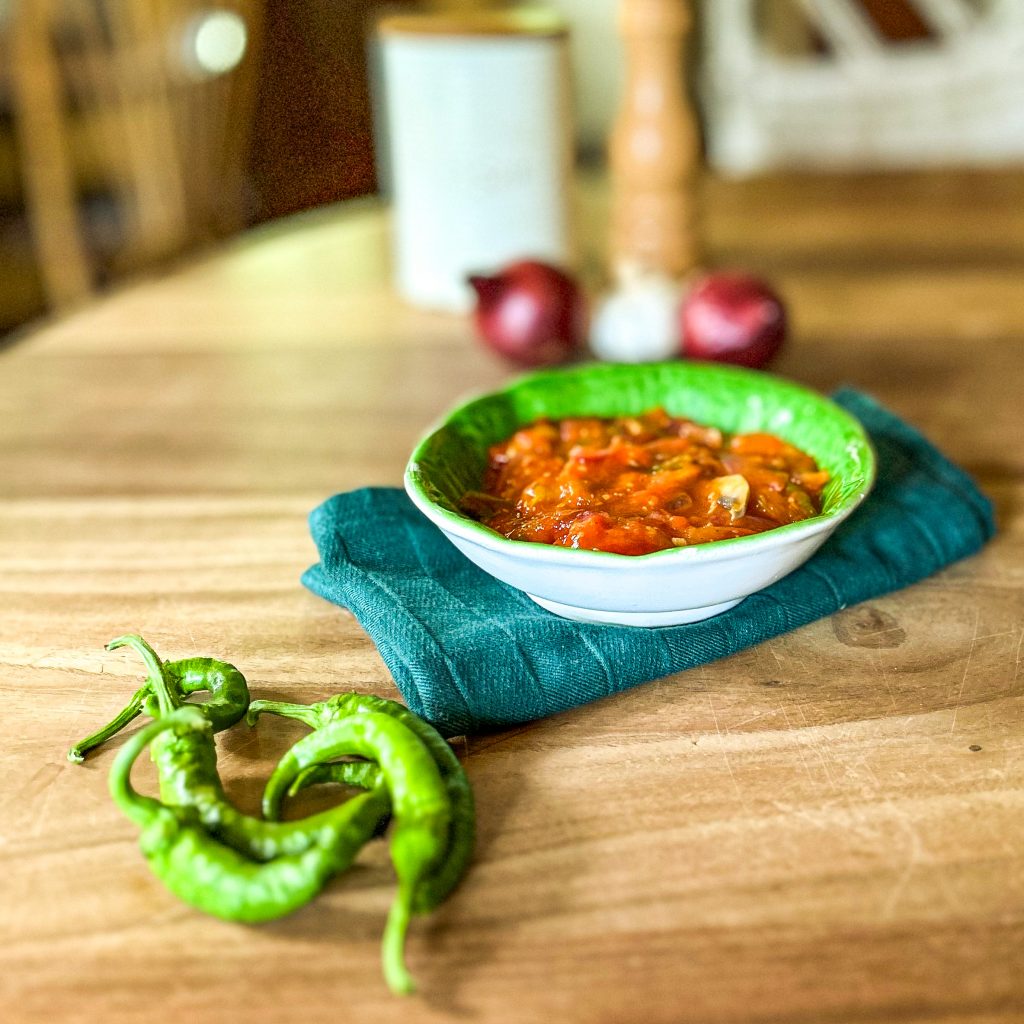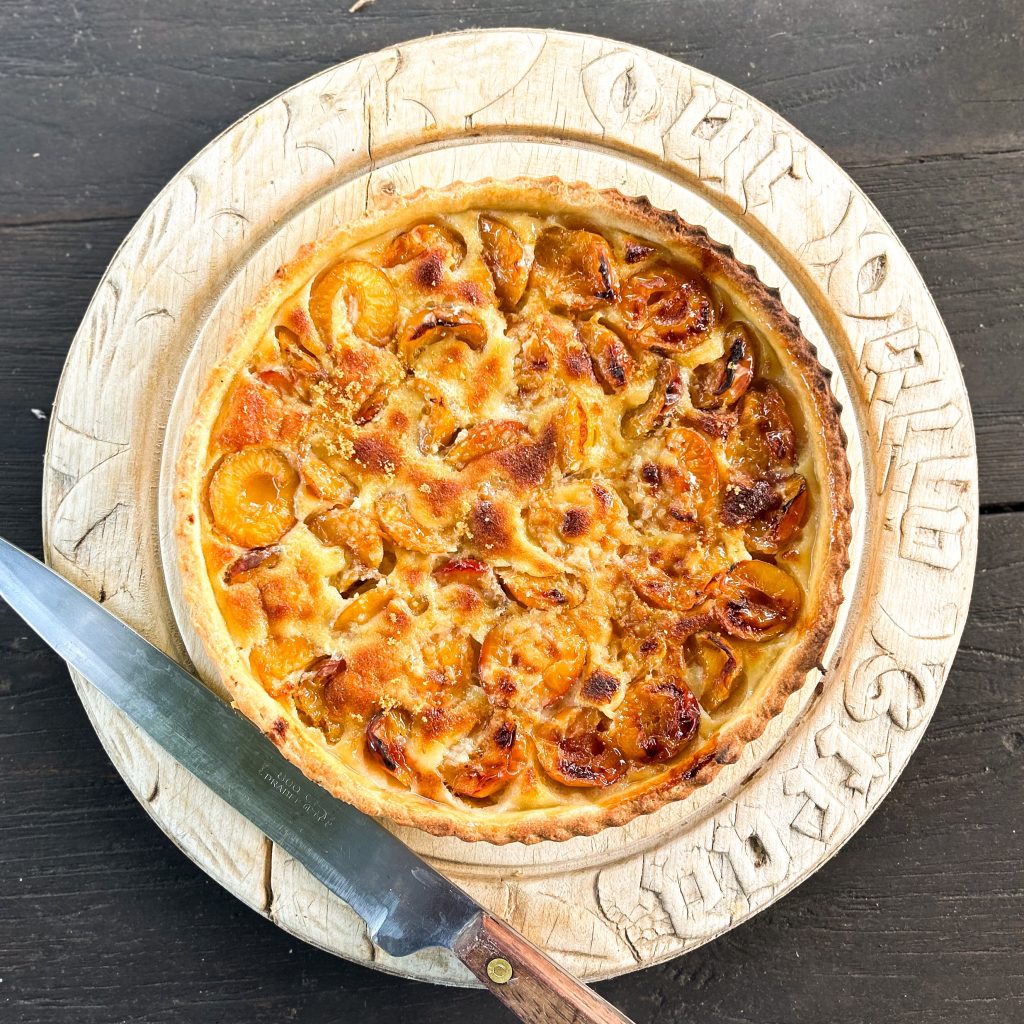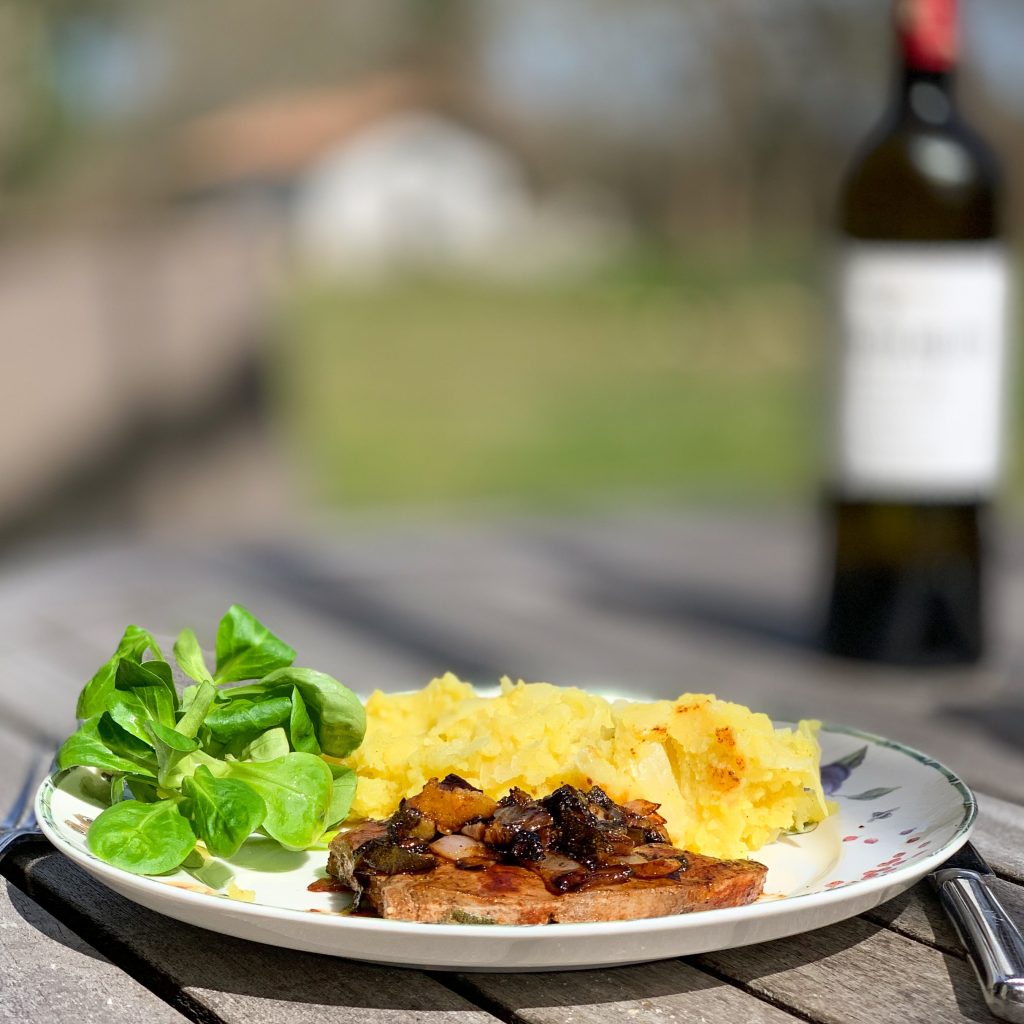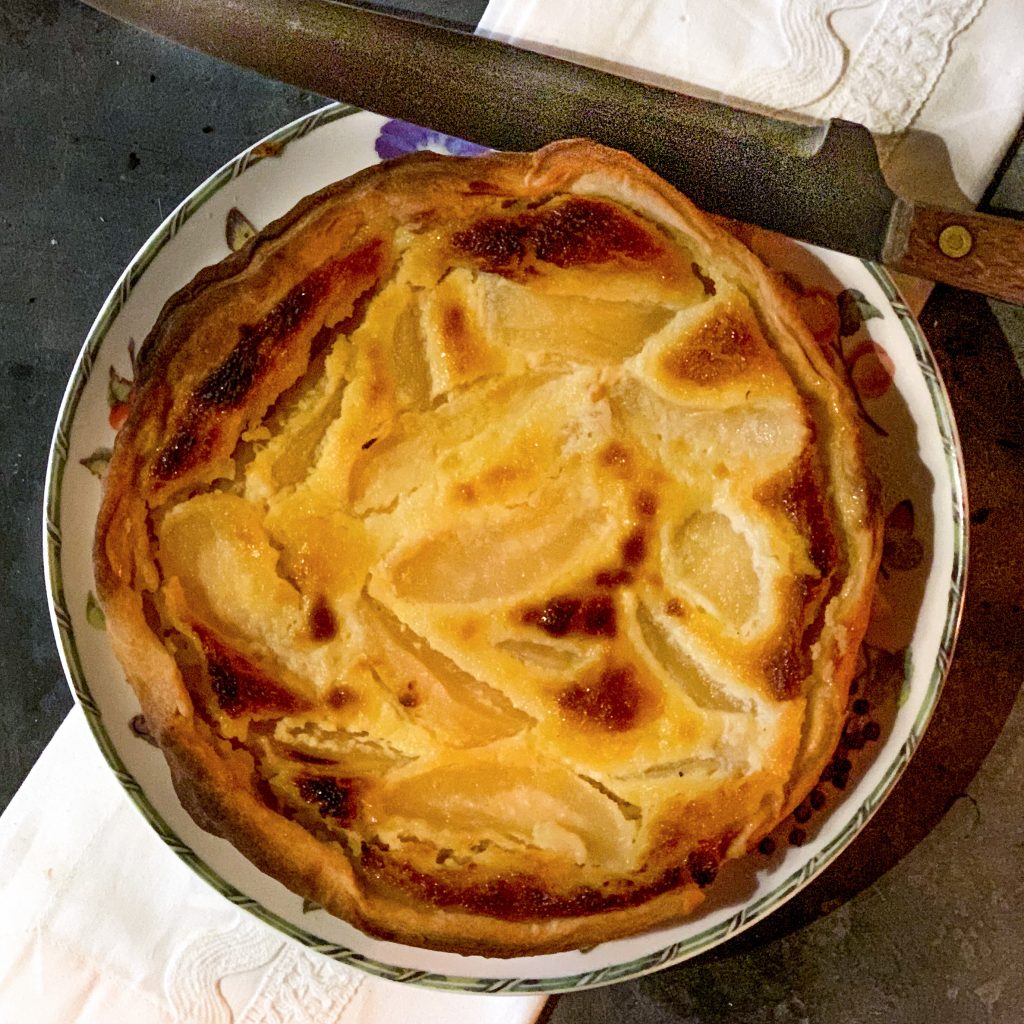-
Basque Piperade and Party Mouse finds our crack cocaine stash

Basque Piperade I returned after two weeks away in August (a cruise around The Adriatic, which was very hot, but absolutely stunning. My photos are here if you’re interested), to even greater heat and forest fires far too close for comfort. Luc, who had stayed at home to look after the animals because he doesn’t really enjoy travelling anymore, had done a great job, with one exception: he had inadvertently invited a frenetic mouse into the house.
Living in the middle of the country, we see quite a few mice. But I have never seen a mouse as brazen as this one. At first, I noticed loud rustling noises in the cupboard, and holes in the pasta packaging. Then she (I’m calling the mouse ‘she’ because mice are feminine in French) started to drag and drop whole walnuts, potatoes, bits of dog food and, to my shame, enormous fluffballs across the kitchen floor at night, which means I come down to even more chaos in the kitchen than I have left the night before.
You’d think that the night-time activity might wear her out. Alas no! She spends her days playing ‘cat and mouse’ with us, peaking her nose out from under the cooker and fridge, and scuttling across the floor in front of us whenever we deign to sit down. She is upstairs, downstairs, in every nook and cranny and never seems to sleep.
I was seriously wondering where Super Mouse was sourcing her crack cocaine, when I stumbled across the reason for her hyperactivity: an enormous hole in the packet of ground Ethiopian coffee blend. Her drug of choice has now been confiscated, and she’s going to have to go cold turkey. It’s just a waiting game now… surely she’ll fall asleep at some point.
Basque Piperade originated in the Basque region, where sun-ripened tomatoes and peppers are plentiful.
Recipe for Basque Piperade (serves 6)
- 600g onions, sliced
- 3 cloves garlic, crushed
- 4 tablespoons olive oil
- 3 green peppers, seeds removed and sliced
- 6 mild red chilli peppers, seeds removed and sliced
- 1.5k tomatoes, skinned
- Sea salt, freshly ground black pepper
- Espelette pepper (or paprika)
Lightly fry the chopped onions and garlic in olive oil in a large saucepan. Skin the tomatoes by blanching in boiling water for a minute or so and then add to the dish. Cut the peppers into thin strips and add to the tomato mixture. Season with salt and pepper and Espelette pepper and leave to simmer on a low heat for at least an hour, or until the mixture begins to caramelise very slightly.
Traditionally, piperade includes beaten eggs cooked in the vegetable mixture. Often a thick slice of Bayonne ham is fried and served over the top. It is also good with fried or poached eggs on top.
-
Mirabelle plum tart and I take on a photo booth

Mirabelle plum tart My iPhone reminded me of my appointment at the mairie to renew my identity card, I grabbed everything, or so I thought, and ran. Unfortunately though, I fell at the first hurdle; I’d forgotten my photos. I was dismissed, and given another appointment for the next day when I was told to ‘make absolutely sure I had everything with me’.
I found an extremely bossy photo booth and even managed, after a bit of haggling, to find the right change. Once the booth had taken my money though, it became even more obnoxious. It ordered me to sit still and remove my glasses, which I did, because its tone made me not inclined to argue. It then told me to read the small print. WTF? How on earth was I supposed to read the small print sans glasses? I bluffed my way through the tyrannical instructions, being extra careful to remove my all my earrings and especially NOT TO SMILE. There was little risk of me smiling; by this time, I was beginning to feel I would never smile again.
Luc was quite unsympathetic, saying that I turn every little thing, even the most mundane, into a Major Diplomatic Incident. At the mairie the next day, my application for a new ID card was declined, as my photos didn’t fit the bill: my hair was flying out of the frame, one of my ears wasn’t on show, and I was smirking, presumably from rapidly impending hysteria. So I now have to repeat the whole process. I actually prefer my chances of explaining my way out of an expired ID card, than taking on that photo booth again…
We have a mirabelle plum tree in our garden, and this is the first year it has borne fruit since it was planted 15 years ago. I often find plums very acidic, but ripe mirabelle plums contain hardly any acid and are very sweet, making them easy on sensitive stomachs.
Recipe for mirabelle plum tart (serves 4-6)
Puff pastry:
- 100g flour
- 50g butter, diced
- 1 egg
- 2 tablespoons water
- Pinch of salt
Filling:
- 18 (roughly) mirabelle plums, cut in half, stone removed
- 30g sugar
- 40g ground almonds
- 100ml cream
- 4 tablespoons fruit alcohol (I used calvados)
To make the puff pastry:
Mix the ingredients together in a mixer, wrap in clingfilm and refrigerate for at least 3 hours, or even overnight. Roll the pastry out (remember to sprinkle flour on your work surface), and fold and roll several times, remember to turn the pastry 90° each time. Wrap in clingfilm and refrigerate again. To use the pastry, just roll out again according to the shape of your pastry case.
To make the filling:
Arrange the plums in the pastry case, then mix the other ingredients together and pour over the fruit. Bake in a very hot, preheated oven (220°C) for 30 minutes. May be served hot, lukewarm, or cold.
-
Liver in balsamic vinegar sauce, and victory for restaurant-goers

Liver in balsamic vinegar sauce I saw a picture in British newspaper that said everything about France, and in particular, Bordeaux. It was of a couple sitting outside on a restaurant terrace in the centre of Bordeaux (the Place de la Victoire, as it happens). They were calmly eating their dinner, and drinking their obligatory red wine, while rioters and demonstrators caused visible commotion in the background. There was even a ‘fire of wrath’ burning close-by.
The photo reminded me of the time, many years ago, that we had a lunch booking at a Michelin-starred restaurant in Auxerre. It was before GPS and, as we didn’t have a map, we had to stop and ask a policeman for directions to the restaurant. The time was approaching 1pm and the policeman, panicked at the idea that we were going to be late for our table, not only directed us to the restaurant, he also held up the traffic flow in both directions to allow us to do a U-turn! The French have always had their priorities straight.
Liver health benefits
Liver should be organic, preferably, and very fresh. It will be improved greatly by being soaked in lemon juice for several hours before cooking. This improves the texture, and draws out any impurities. Liver is an extremely high-quality source of protein, as it provides all of the essential amino acids. In addition it provides:
- Vitamin B12, which helps the formation of red blood cells and is also involved in healthy brain function.
- Vitamin A, which is important for normal vision, immune function and reproduction.
- Riboflavin (B2), which is important for cellular development and function, and helps turn food into energy.
- Folate (B9) which is an essential nutrient that plays a role in cell growth and the formation of DNA.
- Iron, an essential nutrient that helps carry oxygen around the body. The iron in liver is heme iron, the kind most easily absorbed by the body.
- Copper, which activates a number of enzymes, which then help regulate energy production, iron metabolism and brain function.
- Choline, which is important for brain development and liver function.
Recipe for liver in balsamic vinegar sauce (serves 4)
- 4 slices liver (I used calves liver)
- Juice of 2 lemons
- Cornflour
- 1 tablespoon butter
- 1 tablespoon olive oil
- 6 shallots, finely chopped
- Sea salt, freshly-ground black pepper
- 1/2 teaspoon paprika
- 6 tablespoons balsamic vinegar
Marinate the liver slices in lemon juice for several hours. Pat the slices dry and dust lightly with cornflour. Melt the butter and olive oil in a large, non-stick frying pan and gently brown the sliced shallots. Remove the fried shallots and set aside. Add the liver to the frying pan and cook on a fairly high heat, several minutes on each side depending on the thickness of the slices. Season and then add balsamic vinegar, bring to the boil, return the shallots to the pan and serve immediately!
-
French pear and almond tart and lost in the forest

French pear and almond tart A neighbour and I set out on a walk with the dogs early last Saturday afternoon. It was beautifully sunny and, as the sun sets around 5.30 in November, we had plenty of time. Or so I thought. We stumbled upon an area that I hadn’t been to for some time, but the landscape had changed completely as trees had been cut and new ones planted. About an hour and a half into our walk I suddenly realised that I had absolutely no idea where we were! I have ‘getting lost’ form, and a few years ago Luc spray painted a few key trees in the area as a guide. But the trees had been cut down; my landmarks had turned to sawdust!

Landes pine forest Deeper and deeper into the forest
I called Luc, but he was in the middle of a football match — the urgency with he told me this made me wonder whether he’d been called in to replace the centre forward — and said I’d have to wait until half time. This gave us ample opportunity to cast ourselves even further adrift. We appealed to the dogs for their take on the quickest way home (I’ve often abandoned the reins on horseback as horses have built-in GPSs and are excellent at finding their way back to the stable). Alas, the dogs were having so much fun I suspect they led us astray further to keep the party going.

Cranes flying home for the night Cranes, helicopters and cannibalism
With the sun setting at an alarming rate, and the wintering cranes returning to their digs at a nearby lake, my thoughts started turning to rescue helicopters, hungry wild boar, and cannibalism. By the time it was actually dark, to our relief, we hit a tarmac path, although we had no idea where it led. Sometime later we spotted flashing car lights in the distance, tapping out what looked like a message in flashlight morse code, possibly ‘French team replacement saves damsels in distress during half time’? We were haphazardly bundled into the back seat of the car as he had ‘a match to get back to’.

A very manic ‘help I’m lost and it’s getting dark’ grimace Get lost app
I’ve since installed an app on my ‘phone, which shows me how to retrace my steps if I get lost. I’m already wondering how long I’m going to be amused by its bizarre and random bilingual bossiness. Every so often it springs to life and says: ‘You ‘ave marché quatre kilomètres in fifty-deux minutes’, ‘Allo, ‘Allo-style. I’m not sure that getting lost wasn’t preferable. One thing’s for sure: The dogs were ecstatic about their prolonged outing; we heard Java’s friend throwing himself at the door at 6am the next morning for a replay.
Recipe for pear and almond tart (serves 4-6)
Puff pastry:
- 100g flour
- 50g butter, diced
- 1 egg
- 2 tablespoons water
- Pinch of salt
Filling:
- 1 tin of pears
- 40g sugar
- 50g ground almonds
- 100ml cream
- 4 tablespoons fruit alcohol (I used calvados)
To make the puff pastry:
Mix the ingredients together in a mixer, wrap in clingfilm and refrigerate for at least 3 hours, or even overnight. Roll the pastry out (remember to sprinkle flour on your work surface), and fold and roll several times, remember to turn the pastry 90° each time. Wrap in clingfilm and refrigerate again. To use the pastry, just roll out again according to the shape of your pastry case.
To make the filling:
Arrange the pears in the pastry case, then mix the other ingredients together and pour over the pears. Bake in a very hot, preheated oven (220°C) for 30 minutes. May be served hot, lukewarm, or cold.
-
Courgette flower fritters and a cruel summer

Heavenly courgette flower fritters Léo and I went to London in June, leaving Luc in the company of a couple of deer that appear to have moved in. The lady deer, who Luc calls Georgette, is quite pally with the horses and they graze together in the sun every morning and evening, but the male, Georgio, is noisily territorial and barks at Luc if he approaches ‘his’ field after 9.15pm. For some reason, 9.15pm is the time at which time it becomes ‘his property’ and trespassers will be barked at, throatily, hauntingly, and incessantly. You can almost see the testosterone cloud descend to thicken the night air.
On our return from London, where poor Léo spent five days spluttering in semi-isolation with a covid-not-covid virus, my phone clock proved resistant to reverting to French time. This meant that I spent a couple of days after my return arriving an hour late for every single appointment. The worst thing was the length of time it took for me to realise that my phone had gone rogue.



Léo is becoming increasingly concerned by his father’s extravagant use of emojis. We went shopping a few days ago and received a message to buy chicken feed. Léo, from beneath furrowed brow, said ‘but we don’t have chickens; we have pigeons’. He went on to say that what he found even more worrying was that Luc had compounded his error with several chicken emojis🐔🐔🐔. That evening, Luc wrote to the notary who is currently handling a property transaction for us, adding a 👩🏻 when alluding to the seller (on a positive note, at least he’d got the right species; The mind boggles at the possibilities for misinterpretation and offence had he not.)
Hugo❤️
Ending on a very sad note, the punishing heat we endured a couple of weeks ago proved to be too much for Hugo, our gorgeous black labrador, who was a contributor to this blog (here is a selection). Forty-five degrees is very distressing for an elderly dog with respiratory difficulties, and we made the harrowing decision to help him on his way. He is now resting in a peaceful corner of our grounds alongside other departed friends. I imagine them wryly exchanging ‘at least we can have some peace and quiet here’ sentiments. RIP darling Hugo❤️; your endearing but authoritarian ways will be greatly missed, as will your blogs






These fritter are divine. Of course, the courgette flower season is short, so make the most of them while you can. Because they’re eaten so fresh, they contain fair amounts of vitamins A , C, E and K and also minerals such as magnesium, zinc, and calcium.
Recipe for courgette flower fritters (serves 4, although probably fewer!)
- 12 courgette flowers
- 80g flour
- 150ml sparkling mineral water
- 1 soup spoon olive oil
- Pinch sea salt, freshly ground black pepper
- 1 egg, beaten
- 1 clove garlic, crushed
- 6 basil leaves, shredded
Gently rince the flowers, and set aside to dry on absorbant kitchen roll. Combine the flour, water, olive oil, seasoning, egg and garlic well to form a homogenous mixture. Cover the base of a large frying pan with olive oil and heat. Dip each flower into the mixture, coating generously, and then place immediately in the hot pan, and fry both sides. The fritters should be golden-brown, but not burnt. May be served alone with salad, or as an accompaniment.
-
Provencal petit fours and a needy washing machine (on a tropical beach)

We bought a new washing machine a few months ago, when the old one held up a white flag and said: ‘Have mercy, I can’t take any more dog hair!’ The thing is, as sophisticated and Germanically robust as the new one is, I’m not a fan; it’s too angular and white, with too many flashing buttons and digital messages, none of which I understand.
Our new washing machine makes me think, irrationally, of gaudy designer labels, overly whitened teeth and forced metallic laughter. It’s all about pouting ‘look at me’ selfies in front of a tropical beach sunset. It’s smug and needy and gets super het up over fewer ‘likes’ than usual and bad hair days. You have to be really committed to the lure of clean clothes to summon up the patience and acumen to turn it on, and even then it might throw a hissy fit and refuse to comply for no known reason. I’ve decided to fly it out to a tropical island and abandon it on the beach; when there’s no one to look at it, admire it, even be annoyed by it, it will just cease to exist.
Please, someone point me in the direction of uncomplicated, good-natured white goods and spare me from those with narcissistic personality disorders.
Recipe for Provencal petit fours (serves 4-6)
- 250g puff pastry
- 2 tablespoons Dijon mustard
- Small can of tomato concentrate
- 2 shallots, finely chopped
- 70g grated gruyère (or any hard cheese)
- 6 black olives, sliced
- 6 anchovy filets, cut into small pieces
- Sea salt, freshly ground black pepper
- Paprika
- Twig of fresh rosemary
- 1 egg yolk, beaten
- Olive oil
Place the pastry on a flat surface and evenly spread first the mustard and then tomato concentrate. Distribute the other ingredients evenly over the tomato concentrate, season and remove the rosemary from the twig and scatter over the top. Gently roll the pastry and brush with the beaten egg yolk. Preheat the oven to 180°C. Put the roll in the freezer for about 15 minutes, remove and cut into small slices roughly 1cm thick. Distribute the cut pieces on a baking tray, greased with a little olive oil. Bake for 12 minutes, until golden. Delicious served hot or cold!
-
Galette des rois (king cake) and ghetto blasters

King cake (galette des rois) We were invited to lunch at a friend’s house last Sunday, where we met their handsome, polite, nicely-mannered dog. While we ate, he sat by us with a gentle expression that said: ‘If you’re having trouble finishing, I could possibly be of assistance…’ This is, of course, in stark contrast to Hugo, who barks impatiently and punches Luc in the thigh with his paw, his expression along the lines: ‘Oy! Give me food or I’ll send for backup!’ There is a Peanuts cartoon, in which Woodstock, Snoopy’s feathered friend, sends Snoopy an invoice for damages at a party he had hosted. I’m so glad our dogs are never invited to parties; it would ruin me financially.

An impeccably behaved dog I recently came across some funny stories on Twitter, and one of them made me laugh so hard that I dislocated two ribs (the joys of Ehlers Danlos!). Later, wandering aimlessly around the corridors of the local hospital, in my usual mask-induced daze (OK then, just my usual daze), it struck me that the ambient music was identical to a playlist I had on my ‘phone. When, in passing, I mentioned this coincidence to the doctor’s secretary, she said, very kindly, and in the hushed tones usually reserved for maniacs and idiots, that actually the music seemed to be coming from my handbag. I had inadvertently transformed my handbag into a little leather ghetto blaster!
Catty critiques
Luc is using our fussy cat as a means to critique the food I prepare. He keeps saying things like ‘the cat didn’t finish the beef bourguignon because he found it a bit fatty’, or ‘Minou preferred the Coq au Vin you made last time’. The cat had better learn to stop bellyaching, or his homemade food is going to end up in the dogs’ bowls…

Minou in his castle Galette des Rois (or King Cake) has been a tradition in France since the 14th century. It is served on 6th January to celebrate Epiphany, although they are generally available throughout January. The ‘king’ is represented by a ‘fève’, or charm, hidden within the cake. The person to come across the ‘fève’ in their slice of cake, becomes ‘king’ and has the dubious honour of wearing a paper crown for the day.
Recipe for king cake (serves 6)
- 400g puff pastry
- 2 tablespoons apricot jam
- 75g butter
- 100g sugar
- 2 eggs, beaten plus 1 egg yolk
- 140g ground almonds
- A pinch of salt
- 2 tablespoons Cognac or Armagnac
Preheat the oven to 200°C. Divide the pastry in half, roll out each piece and cut into roughly 25cm rounds and place one round on a baking sheet. Spread the apricot jam over the pastry (not quite reaching the edges). Beat the softened butter and sugar together until light and fluffy, then add the beaten eggs. Stir in the ground almonds and salt and add the Cognac/Armagnac. Spoon the mixture over the jam and spread evenly. Brush the edges of the pastry with a little water and cover with the second round, pressing at the edges to seal. Make a pattern on the top with a sharp knife, then brush with egg yolk. Bake for 25-30 minutes until golden. May be served warm, but not hot, or cold.
-
Basque cheesecake and mad cows

Basque cheesecake Yesterday I decided to give blood, and ‘phoned the blood bank for instructions. I was asked a couple of questions about my age and health, then subjected to some rather indiscreet inquiries as to my ‘tendency to sluttiness’. After that, apparently randomly, they asked if I had lived in the UK between 1980 and 1996, which, although I now have dual nationality, I had. Gauging their reaction, I might have said that my favourite hobby was smothering kittens, because all of a sudden the warm tone switched to ice-cold and, following consultation with colleagues and perfectly audible mutterings about ‘mad cows’, I was told that they didn’t want my blood after all.
With both my character and honour well and truly assassinated, I haughtily replied that it was their loss, but that the name-calling was TOTALLY OUT OF LINE (I may have been shouting at this point). It was only afterwards, once I’d hung up and reined in the paranoid ranting, that I realised they didn’t want my blood because of the Mad Cow Disease outbreak in the 80s and 90s in the UK, and not because it belonged to a mad cow…
This cheesecake was a real hit, unlike my blood. It’s very simple, but light, and with a gorgeous burnt caramel flavor.
Recipe for Basque cheesecake (serves 6)
- 20g butter
- Handful of raisins
- 2 tablespoons rum
- 450g cream cheese
- 125g cane sugar
- 1 teaspoon vanilla extract
- 3 eggs
- 250ml cream
- 20g coconut flour (you could use any flour)
- Pinch of salt
Grease (with the butter) a 17cm non-stick cake tin. Preheat the oven to 210°C. Cook the raisins in the rum and a little water until absorbed. Set aside. Place the cream cheese in a bowl, add the sugar, vanilla extract and mix well. Add the eggs, one at a time, still mixing. Lastly, add the cream gradually and then the flour. Once the mixture is homogenous, pour into the buttered cake tin and bake for 45 minutes. The surface of the cake should look burnt/caramelised, but the inside should still be wobbly. Cool before removing from the tin. Serve chilled and then hide before it all disappears!
-
Chicken and morel mushrooms in white wine cream sauce and needy cats

Chicken and morel mushrooms in white wine cream sauce A friend, who has a country house in Burgundy, told me about a problem she’d been having with a particularly ornery billy goat. The goat had got into the habit of appearing in her garden every evening; apparently its sole intent was digging up her roses bushes, and anything else in temptation’s way. She was greatly relieved when she finally managed to track down the owner and explain the damage caused over the past couple of weeks. The goat’s owner, not missing a beat, said: ‘Yes, well I can see he’s made a terrible mess of your garden! So what are you going to do about it? How are you going to keep him out?’ My friend, a psychiatrist, is not usually lost for words, nor ways to handle challenging people, but this exchange left her slack-jawed and well and truly stumped!
What to do with animals

Luc is in Paris for the weekend so I have been left on full-time animal duty, armed with lengthy instructions of What To Do. The dogs I know about, because I’m the one to walk and feed them usually, although I hadn’t factored in the fact that they would play up quite so much during the night. Hugo took it upon himself to move a very heavy armchair and hefty table at 2am. Noisily. And Java, perhaps stressed by the moving furniture, decided to repeatedly throw herself against a glass door.
The pigeons are easy, as all I need to do is throw five handfuls of grain at a certain spot on the grass. Although, accounting for the fact that my hands are much smaller than Luc’s, I should probably make that six handfuls, or so the instructions say. The horses need a precise quantity of hay twice a day, at 9am and 6pm. According to Luc’s instructions, they will try to manipulate me into feeding them at lunchtime, by whinnying in my direction, and stamping their feet hangrily. I am not to be taken in, as their lunch is the plentiful grass buffet, and they are both too fat for more hay. Got it.
Cat neurosis
On to the cat. Oh my god, the cat, a neurotic stray that first moved in about six years ago. Although he wasn’t neurotic when he arrived. He used to catch mice to eat, then little-by-little, Luc started to feed him. At first, it was dry cat food, but he went off that. Then he had expensive tinned food, which he also turned his nose up at after a little while. He now eats home-cooked casseroles, or prime cuts of meat or fish. What I didn’t know (until Friday) was that, in order for him to deign to eat at all, you have to wash his bowl in warm soapy water before every meal (presumably the cat equivalent of warming the plates), talk to him while you are preparing his food, continue talking while he is eating, and only stroke him if he ‘asks’. As my mother said, when I told her about catgate, ‘who would have thought that a great big macho would be such a softie with animals’. I’m still not sure how I feel about my husband being described as a ‘great big macho’, but I’m all catted out and too tired to care!

Minou Recipe for chicken and morel mushrooms in white wine cream sauce (serves 4)
- 30g dried morel mushrooms, soaked overnight in cold water
- 4 shallots, sliced
- 4 skinless free-range chicken breasts, sliced
- Sea salt and freshly-ground black pepper
- 15g butter
- 100g mushrooms, sliced
- 2 bay leaves
- 200ml white wine
- 100ml chicken or vegetable stock
- 200ml double cream
Remove the morels from the soaking liquid, squeezing as much excess water out as possible. Chop any large morels in half and reserve. Season the chicken breasts with salt and pepper. Melt the butter over a medium heat in a large frying pan, add the shallots and chicken and fry gently for a couple of minutes on each side, then remove from the pan and set aside. In the butter that’s left in the pan, cook the soaked, cleaned morels and button mushrooms for a few minutes to soften, then season. Add the white wine, stock and double cream. Bring to the boil, then return the chicken breasts to the pan, coating them in the cream. Lower the heat to a gentle simmer and cook for 6 minutes or so until the chicken is cooked through. Take the chicken out of the pan briefly, turn up the heat and reduce the sauce on full boil until it coats the back of a spoon. Return the chicken to the pan, coat in sauce, adjust the seasoning and serve. Bon appétit!
-
French walnut tart and masking your confusion

French walnut tart A pair of goats turned up, quite unannounced, the other evening. Obviously visitors are always a welcome surprise, but I was a bit thrown by these; I’m not familiar with goat etiquette. Do you stick them in a grange and hope someone will claim them, or offer them dinner and send them on their way? I sent messages to all our potentially goat-owning neighbours, and the consensus seemed to be: ‘Not ours, but it’s hardly surprising they turned up — you run Club Med for animals’.
I have been trying out magnet therapy for my stiff neck. It’s supposed to be very effective for inflammation, and, so far it’s proving to be quite effective. Yesterday, while I was in the process of making dinner with a particularly sharp knife, my ‘phone rang. As I put the ‘phone to my ear, the knife sprang vigourously out of my hand, and onto the magnet on my neck, stabbing me the process. So, although the inflammation in my neck is quite a bit better, I’m now dealing with a minor stab wound.
I’m not really fit to be let loose in public: I keep accosting people I don’t know, and blanking people I do. I’m obviously not the only one to find masked faces a challenge though, because the doctor that jabbed me last week asked if I’d been on the operating bloc recently, as I ‘looked very familiar’. I know I’m a bit vague, but I think I’d remember being operated on so recently… I would, wouldn’t I?

A friend who visited recently made this for us during her stay. I loved it so much, I’ve made it quite a few times since.
Walnuts are full of vitamins and minerals, and are an especially rich source of Omega 3. They are a good source of copper, folic acid, phosphorus, vitamin B6, manganese and vitamin E.
Walnuts are also a rich source of phytosterols and antioxidants which help decrease inflammation. Consuming walnuts can enrich the gut microbiome, increasing good bacteria.
Recipe for French walnut tart (serves 6)
Pastry:
- 150g butter
- 270g flour (I used einkorn flour)
- 1 pinch of salt
- Water
Filling:
- 225g walnuts
- 2 eggs
- 20cl fresh cream
- Drop of vanilla essence
- 100g cane sugar
- 1/2 teaspoon cinnamon, ginger and cardamon
Preheat the oven to 180°C.
To make the pastry, begin by cutting the butter into small cubes. Sift the flours and a pinch of salt together into in a mixing bowl, also adding the cubes of butter. Rub in and blend by hand until the mixture becomes crumbly. Add the cold water, mixing rapidly with a spoon. Remove the mixture from the bowl onto a lightly floured surface. Knead until you obtain a ball of pastry (if the mixture isn’t ‘sticky’ enough to form a ball, you may need a drop more water). Wrap in a clean cotton tea towel or some cling film and leave to ‘rest’ in the fridge for about two hours. This relaxes the dough and makes it easier to use.
For the filling, crush the walnuts and set aside. Beat the eggs, adding the cream, vanilla, and sugar and spices, mixing well. Add the crushed nuts and pour the mixture into the prepared pastry case. Bake at 180°C for 35 minutes. Delicious hot or cold.

French walnut tart